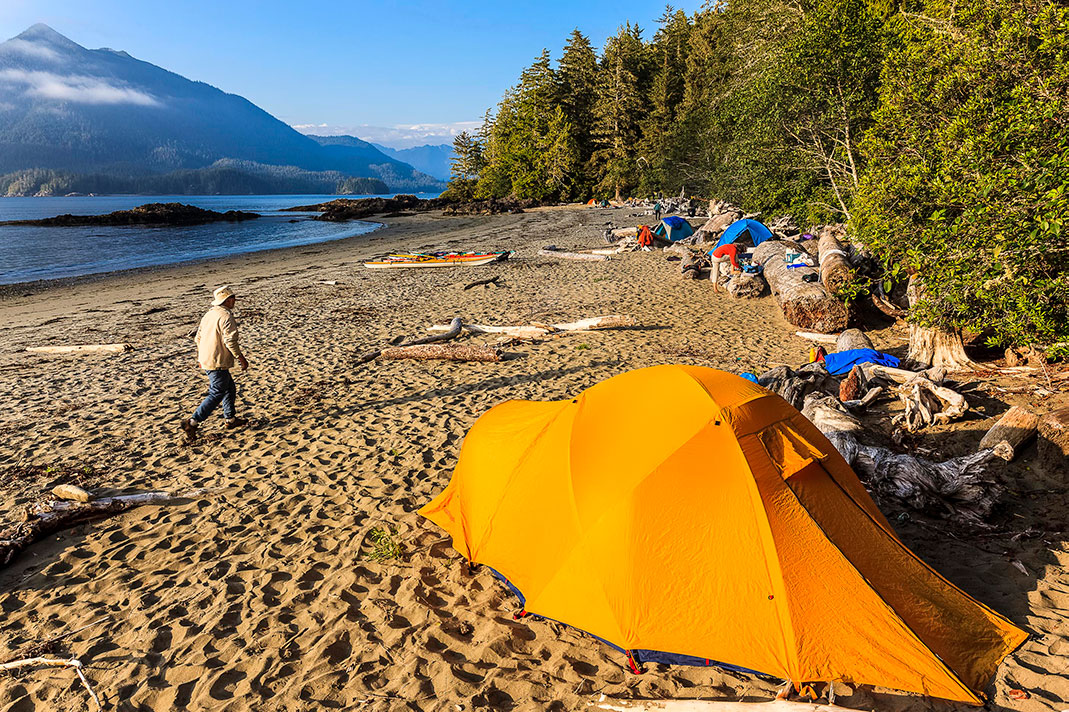
I hand Maria a sandwich. Gazing at fog-shrouded islands and emerald-green peaks, she munches away.
“Less sand next time,” she says as if sand is a condiment I’ve added, like Dijon mustard. We’re on day seven of an outer coast trip camping on wide beaches with afternoon northwesterlies. Sand is seasoning everything.
Paddlers have a complicated relationship with sand. It finds its way into sleeping bags, sandwiches, eyes, camera housings and places best not mentioned in the pages of this family magazine.
Some hate sand with the fervor of holy warriors, while others manage it like an engineering puzzle. And still others see a gritty heaven. More than rudders versus skegs, a sea kayaker’s relationship with sand reveals all you need to know about their paddling personality.
One friend of mine stayed meticulously sand-free for two solid weeks of beach camping. He carefully double-bagged his drybags inside zipped Ikea bags, armored himself with pants and shoes on the beach, and always entered his tent on the leeward side. When we cleaned out our hatches at the end of the trip, his were still sparkling clean. The rest of us needed a Shop-Vac.
Die-hard sand avoiders will do anything to evade camping on the beach, even if it means humping their gear over giant logs and thrashing through dense coastal thickets to some tiny, not-really-flat spot in the forest. One new couple I paddled with got in a shouting match over the choice between flat sand or lumpy forest ground. They didn’t last long.
Another friend reliably reverts to childhood when we land. After stripping off PFD, sprayskirt and helmet, shoes inevitably follow. Then there will be a strange sand jig followed by the sand Olympics, with long jumping, dune rolling and feet burying.
Numerous are the fairweather sand lovers—those who favor the wide open beaches on calm dry days but pivot to grumbling as soon as the wind blows it around or when it gets damp and sticks to their gear. Then you can expect they’ll want to move camp to some gravelly inlet where we’d have to wear shoes in camp.
And don’t forget the sand nerds. In the tropics, one friend made certain I knew that majestic white sand was so soft and fine because it was coral nibbled, digested and pooped out the exhaust pipe of a parrotfish. Others peered at the grains to source their geologic content or—I’m guilty of this one—made everyone guess where the next night’s high tide will be.
I’m firmly in the sand lover category, though less competitive about it than my sand Olympics friend. I love barefoot wandering, easy flops onto a soft surface, and that each morning, tracks will tell me which critters checked out my tent. The drysuit neck gasket rash and sand taking up residence in my kit is a price I’m willing to pay.
As much as I love beaches, there’s another reason for my laissez-faire attitude. Sand always wins. On one photography trip in an exquisite set of dunes, I set up my tent to have a clean spot to manage camera gear. Within an hour, there was an entire dune ecosystem inside the tent, which ended up back in the bag. And sooner or later on every trip, something will slip off a beach log into the sand and get either coated or lost. I just hope it will be a tent stake or a fork instead of my last contact lens. But the beach giveth, as well as taketh away. I’ve found multi-tools, books, food and even coffee on the lam from its previous owner.
I love barefoot wandering, easy flops onto a soft surface, and that each morning, tracks will tell me which critters checked out my tent.
To ease the post-trip transition from sand creature to civilized human, as soon as I get home, I subject everything to a multi-tub waterboarding routine before hanging it up to dry. The first tub usually has enough sand to sell for construction fill. But when I unfold my tarp again this season, you know what I’ll find anyway.
Sand is part of what I love most about sea kayaking. The rugged beauty of the West Coast, with its massive sea arches, caves, crinkly headlands and secret coves, is only possible because the sea is relentless enough to pulverize rocks into those tiny bits that get in my everything.
There are no rock gardens without surf, and surf and sand are inseparable. Although I suppose you could try introducing some parrotfish to eat the rocks and poop them out, if that’s your sort of thing.
This article was first published in Paddling Magazine Issue 64. Subscribe to Paddling Magazine’s print and digital editions here, or download the Paddling Magazine app and browse the digital archives here.
Neil Schulman removes sand from his kayaking gear, cameras and computer keyboard in Portland, Oregon.
“I hate sand. It’s coarse and rough and irritating, and it gets everywhere.” —Anakin Skywalker, and 50 percent of sea kayakers everywhere. | Feature photo: Ron Watts